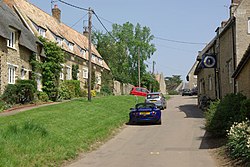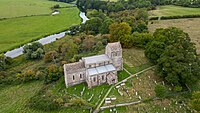Wadenhoe
| Wadenhoe | |
| Northamptonshire | |
|---|---|
 Church Street, Wadenhoe | |
| Location | |
| Grid reference: | TL010834 |
| Location: | 52°26’22"N, -0°30’53"W |
| Data | |
| Population: | 244 (2011) |
| Post town: | Peterborough |
| Postcode: | PE8 |
| Dialling code: | 01832 |
| Local Government | |
| Council: | North Northamptonshire |
| Parliamentary constituency: |
Corby |
Wadenhoe is a village in Northamptonshire, beside the River Nene, about four miles from Thrapston and ten miles from Corby. The Nene Way long-distance footpath passes through the village.
The population of the parish at the 2011 census (including Pilton and Stoke Doyle) was 244.
The village's name means 'hill-spur of Wada'.[1]
History
There is evidence of prehistoric occupation by way of earthworks.
The original village listed in the Domesday Book was located north-east of the church: the area surrounding the church is now a Site of Special Scientific Interest.[2] There is extensive evidence of Roman occupation and encampment within the village, with finds of coins and pottery recorded. The ancient sites are not protected.
The manor and lands have changed ownership many times over the centuries, the position of the current village is near to its position in the Saxon period.[3]
The manor of Wadenhoe was held by a half a knight's fee or through the Honour of Winchester, whilst other holdings were direct from the King. At the time of the Norman Conquest of 1066 Wadenhoe became part of Rockingham Forest.[4]
The village was named 'Wadenho' in the Domesday Book in 1086, and was within the Hundred of Navisford – one of eight Hundreds held by the Abbey of Peterborough, granted by Richard I[5] The Tenant in Chief as recorded in Domesday was Bishop Geoffrey of Coutances and the Lord at that time Aubrey De Vere. The population was recorded as 31 households.[6] The manor remained property and in full possession of the de Vere family until 1229.
A water-mill and free fishery are mentioned in 1356 and two mills are referred to in 1656 and again in 1818.[4]
Parish church

The church of St. Michael and All Angels has a tower which is all that is left of a late 12th-century church (built around 1195 to 1200). The chancel and nave of which were rebuilt some time in the next century. The aisles appear to have been rebuilt and widened in the 14th century.
In 1901 there was an extensive restoration of the fabric when the floors of the nave and aisles were lowered to their original level and the tower was underpinned to a solid foundation. The roofs are all modern, those of the nave and aisles being leaded and the chancel roof tiled.
There are 17th-century tombs and headstones in the churchyard, and on one of the buttresses on the south side are three scratch dials.
The Church was used as the backdrop for the opening scenes of the 1999 film version of A Christmas Carol starring Patrick Stewart.
Pictures
| ("Wikimedia Commons" has material about Wadenhoe) |
-
Wadenhoe Village Hall
-
Church Street, Wadenhoe
-
Sundial at Wadenhoe
-
Cottages at Wadenhoe
-
Path to Wadenhoe Church
-
Wadenhoe Lock and sluice gate
-
Wadenhoe Church from the car park
-
River Nene, Wadenhoe - geograph.org.uk
-
Church Street, Wadenhoe - geograph.org.uk
-
Milk Churn Stand, Wadenhoe - geograph.org.uk
-
Footpath from Achurch to Wadenhoe
-
The Nene Way near Wadenhoe
-
Mill pond and Mill Wadenhoe
-
Wadenhoe Mill on the River Nene
-
Footpath bridge between Achurch and Wadenhoe
-
Trees in a parkland setting, Wadenhoe
-
Mooring on the River Nene at Wadenhoe
-
Footbridge on the Nene Way between Aldwincle and Wadenhoe
Outside links
- Details of the lock on the Nene with some information on the village
- A walk featuring, Wadenhoe, Aldwincle and Achurch
- Wadenhoe Local History Group
References
- ↑ "Key to English Place-names". http://kepn.nottingham.ac.uk/map/place/Northamptonshire/Wadenhoe.
- ↑ Wadenhoe Trust
- ↑ "Rights of Way, Northamptonshire". Northamptonshire District Council. http://www.northamptonshire.gov.uk/en/councilservices/Transport/Documents/PDF%20Documents/AldwincleWadenhoe.pdf. Retrieved 24 August 2012.
- ↑ 4.0 4.1 Page, Duffrey (1998). The Story of Wadenhoe. pp. 39–65. http://www.wadenhoehistorygroup.org/books.html.
- ↑ A History of the County of Northampton - Volume 3 pp 123-124: Navisford Hundred (Victoria County History)
- ↑ Wadenhoe in the Domesday Book


















